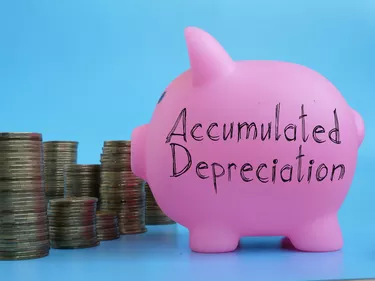
Stating an asset's true value is an essential effort when a company reports its income for purposes of paying taxes or when the value of a business must be established as a precursor to its sale. Reporting depreciation expense is essential to each of these efforts because the depreciation expense reduces the carrying amount of a fixed asset over time, which reflects the fact that an asset's value is consumed over time.
Unlike accumulated depreciation, which is a contra asset that's reported on a balance sheet, depreciation expense is a portion of a fixed asset's cost that is expensed for a certain period and reported in the income statement. In both cases, depreciation reflects the degree that the value of an asset, such as machinery or equipment, diminishes over time relative to its use.
Video of the Day
Video of the Day
Definition of Depreciation
An asset depreciates over time relative to its use or its contribution to a company's revenue stream. An asset's depreciation is reported as an expense in an income statement on a quarter-by-quarter or year-by-year basis.
A depreciation expense is an essential element in the calculation of a company's net income in that net income must reflect a company's earnings after the expenses the company incurs to operate the business are accounted for.
Consider also: What Happens If I Don't Depreciate My Rental House?
Depreciation Expense
Depreciation is an accounting process that allows a company to earn revenue from an asset and allocate its cost over its useful life. As a result, the amount of depreciation expensed in a period reduces the company's net income for that period.
Accumulated Depreciation
In contrast, an asset's accumulated depreciation reflects the asset's wear, or the total amount its value has diminished as of some point in time due to its usage in producing products or services. Accumulated depreciation is reported in the balance sheet.
Reporting Depreciation Expense
Rather than report depreciation expense as a contra asset that's reported on a balance sheet (as is accumulated depreciation), depreciation expense is reported in the income statement as an operating expense. In this case, the reported depreciation expense for an accounting period is the portion of the asset's original value, as determined by its acquisition cost, that's been diminished by its use to produce products or services in that period.
Consider also: Depreciation of Business Assets: Definition, Calculation & How it Affects Your Taxes
Example of Depreciation Expense
When an asset is used in a company's production process, the cost of that asset is listed as an operating expense in the income statement. The amount that you expense should reflect the portion of the asset's acquisition cost that is attributable to the production process during an accounting period.
For instance, a furniture manufacturer can attribute certain revenues and costs to a piece of machinery that is used in the production of desks during the year 2021. The company depreciates the attributable cost of that machinery over the asset's life, say five years.
Assume that a machine, which costs $400,000, is expected to have a value of $50,000 in five years and that the company will record the asset's depreciation over five years using the straight-line method. In this case, you calculate the machine's annual depreciation as follows: (($400,000 - $50,000)/5 = $70,000)
Reporting Accumulated Depreciation
Accumulated depreciation increases over time as an asset's value is diminished by a company's usage of the asset to produce products or services. Depreciation is accumulated from the moment an asset is acquired and placed into service to the point at which a company removes the asset from service.
An asset's accumulated depreciation is reported in a company's balance sheet as a contra asset account that has a credit balance. That account balance increases during each financial reporting period so it equals the asset's current depreciated value.
Typically, accumulated depreciation does not appear as a separate line item on a company's balance sheet. Instead, the current value of long-term assets – the asset's purchase price less accumulated depreciation – is reported.
Depreciation Expense vs. Accumulated Depreciation
The amount that a company asset is depreciated during a certain period – a quarter or year – is the amount the company will depreciate, or reduce an asset's value, during that period. That value is the company's depreciation expense that's incurred due to the use of that asset during an accounting period.
The total amount that a company has historically depreciated an asset over time is the asset's depreciated value. A company reports the depreciated value of all its assets over time in its quarterly or annual balance sheet.